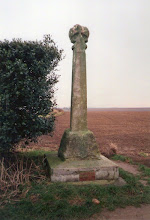This first encounter in an English Civil War mini campaign for DBA-RRR designed by 'Cromwell' of Fanaticus employs 6 elements a side: 4 cavalry (parliamentarians) or Knights (Royalist), one dragoons and one shot.
Linear obstacles were included using the DBACW rules (Keep it Simple Rules) for this terrain type (slightly adapted to reflect troop types in DBA-RRR).
- Stone walls: Foot, Gun/Cannons and mounted are classed as being 'in cover' when defending a stone wall (shooters firing into cover get -1 to distance shooting. Defenders get a +1 close combat modifier when in close combat). They are classed as bad going and only foot (excluding cannon/guns) can cross stone walls and they must have sufficient movement for the entirety of the base to clear the wall in that turn (ie. cannot be left straddling the wall). Groups can only cross in one element wide columns. I play it that it must always be clear which side of the wall a unit is on - so you cannot have an element of a group straddling the fence. They are impassible terrain when it comes to outcome moves for mounted and cannons/guns. Impetuous mounted do not advance across the wall if their opponent is destroyed/recoiled/flees.
- Hedges are counted as 'minor linear obstacles' - they count as bad going and have the same effect on movement as stone walls. Hedges provide no modifiers to distance shooting or close combat.
- Linear obstacles block line of sight except where the shooting element has its firing edge, and/or the target has the edge being shot at, hard up against the wall/hedge.
This adaption may have some 'bugs' still - but I/we just apply common sense to solving problems.
Beyond the initial campaign 'rules' I imposed some set-up and movement conditions in the first bound. I decided the parliamentarians should deploy on the bridge over the River Teme advancing in a column along the road (excepting the element of shot - mostly because there was not room). The Royalists deployed in the open fields (Wick field) out of direct sight of the exhausted Parliamentarian column.
The Royalists were given the opening move and then Fiennes' column was obliged to advance a full move along the road into the lanes beyond the bridge.
The action began with Rupert ordering half of his cavaliers to sweep wide on the Royalist right in the hope of catching Fiennes' column in the rear. The remainder of his mounted troops spurred on into the lane while the shot and dragoons secured the hamlet of Lower Wick. The Parliamentarian column was halted with a volley of musketry as they tramped down the lane.
Fiennes' dragoons were thrown back by the volley but they quickly took cover behind the hedges. Royalist and Parliamentarian horse faced each other at either ends of the lane awaiting the outcome of the musket duel that ensued. Meanwhile, Rupert's flanking manoeuvre continued. Fiennes' led the rear of his column out of the lanes to meet the charge.
As the fighting in the lanes reached a crescendo the cavaliers on Rupert's right wing pushed the Parliamentarian cavalry back to the banks of the Teme (which ended up as a paltry river in this game). Fiennes called more of his cavalry out of the lanes to counter this push and the impetuous cavaliers were caught in the flank with heavy losses (1 element of cavaliers (Kn) lost).
 |
| Rupert's cavaliers charge down the lane as the parliamentarian dragoons fall back in a hail of musketry. |
 |
| Fiennes orders in a third troop of cavalry to support his hard pressed left flank. |
 |
| The impetuous advance of Rupert's cavaliers pushes the parliamentarian horse back into the river Teme but Fiennes leads a decisive counter charge surrounding and decimating the Royalist left flank. |
At this apex of the battle, the parliamentarian foot managed to rally in the woods next to the hamlet and swept into contact with Rupert's mounted troops in the lanes. Unable to manoeuvre, the leading troop were trapped by a deadly volley of musketry at close quarters.
Alas, the dash and daring of Prince Rupert was not enough to carry the day. The Royalists fell back to lick their wounds destined to meet the parliamentarians in the first major battle of the civil wars in a little over a month at Edgehill.











